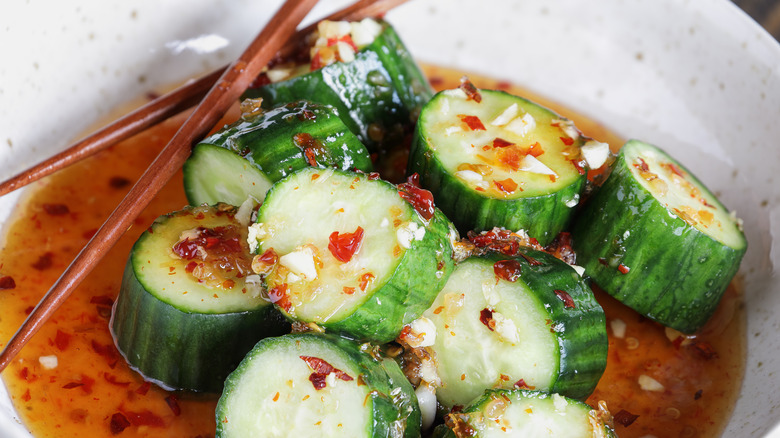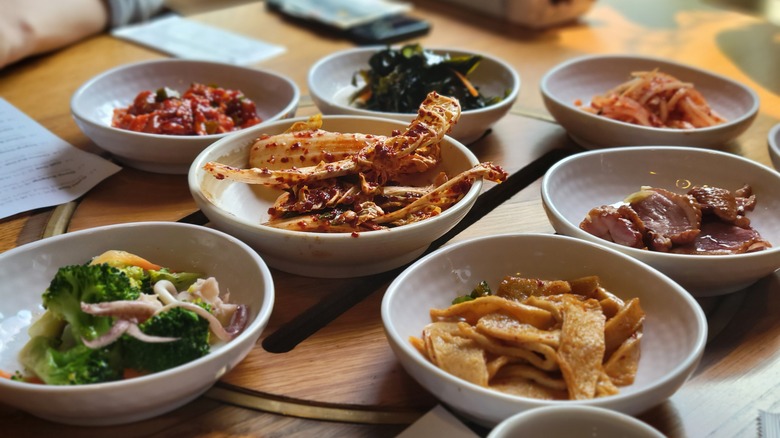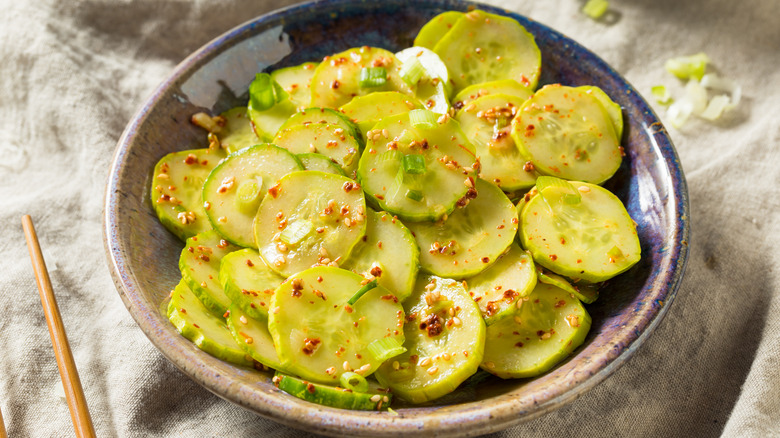Oi Muchim Are Korean Cucumbers That Blow Dill Pickles Out Of The Water
It might be unfair to pit two types of pickled cucumber dishes against each other, but that's what we're going to do (in the name of culinary hunger games, of course). The two contestants are oi muchim, a Korean spicy cucumber dish and dill pickles, the tangy cucumbers soaked in brine. While both share cucumbers as their base, their flavors, preparation methods, and food pairings differ significantly.
Dill pickles are more ubiquitous. It is readily available in most supermarkets and considered a must-have in burgers. In comparison, oi muchim is a standard side dish (or banchan) in Korea that's now gaining traction outside the Korean community, thanks to cookbooks like Eric Kim's "Korean American: Food That Tastes Like Home," as well as Korean American eateries.
It helps to first understand banchan, as it is a building block in Korean food and accompanies every meal. Bachan can be classified by its cooking techniques; there's the more popular kimchi (fermentation), bokkeum (lightly sautéed), jorim (braised), and jjim (steamed). As for oi muchim, it falls under the namul muchim category, which refers to lightly seasoned ingredients. What makes it stand out compared to dill pickles is its blend of spicy, tangy, and subtly sweet flavors that pair well with a range of food, both Korean and non-Korean.
Oi muchim is a speedy side dish
The process of making oi muchim starts with slicing the cucumbers and rubbing it with salt, sugar, and gochugaru (Korean chili flakes) to draw out water content from the cucumbers. The cucumbers are then drained or patted dry and tossed with a dressing that can include any combination of garlic, sesame oil, soy sauce, rice vinegar, and sesame seeds. There's no long pickling process here; the dish can be made the same day you want to serve it.
The final product is a crunchy, tangy, refreshing and slightly spicy salad that pairs well with heavy meals. Despite the kick that comes from the gochugaru, it is refreshing, which makes it a great complement to heavy meals.
In comparison, making dill pickles is easier, as it only requires water, salt and vinegar. But it takes a few weeks for the cucumber to pickle and develop its flavor; it's not a quick dish. Dill pickles also become soft from the pickling process, so they don't have the same crunchy texture as oi muchim.
Use cucumbers with low water content for the best outcome
One of the important steps in making oi muchim is salting the cucumbers to draw out the water content. If the cucumbers are full of water, they'll become soggy after a few hours instead of staying crisp.
The best thing to do is pick a cucumber variety that has low water content. Persian cucumbers are a good option — they don't have the seeds in the middle, which increase water content. Other recipes use Kirby or English cucumbers, too.
Now that you know how to make oi muchim, the next step is to use it. The obvious pairing for oi muchim is a rich, heavy Korean dish, but it's also a great side for any barbecue or meat-heavy dish. Go a bit further and include it in burgers and wraps instead of dill pickles and see how you like the concoction.


